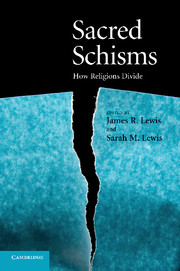Book contents
- Frontmatter
- Contents
- List of figures
- Notes on contributors
- Acknowledgments
- Introduction
- PART I THEORETICAL OVERVIEW
- PART II SURVEY OF SCHISMS IN SELECTED TRADITIONS
- PART III CHRISTIAN TRADITIONS
- PART IV WESTERN ESOTERIC TRADITIONS
- PART V NON-WESTERN/POSTCOLONIAL TRADITIONS
- 12 Succession, religious switching, and schism in the Hare Krishna movement
- 13 Schisms within Hindu guru groups: the Transcendental Meditation movement in North America
- 14 Schism in Babylon: colonialism, Afro-Christianity and Rastafari
- Index
- References
13 - Schisms within Hindu guru groups: the Transcendental Meditation movement in North America
Published online by Cambridge University Press: 24 October 2009
- Frontmatter
- Contents
- List of figures
- Notes on contributors
- Acknowledgments
- Introduction
- PART I THEORETICAL OVERVIEW
- PART II SURVEY OF SCHISMS IN SELECTED TRADITIONS
- PART III CHRISTIAN TRADITIONS
- PART IV WESTERN ESOTERIC TRADITIONS
- PART V NON-WESTERN/POSTCOLONIAL TRADITIONS
- 12 Succession, religious switching, and schism in the Hare Krishna movement
- 13 Schisms within Hindu guru groups: the Transcendental Meditation movement in North America
- 14 Schism in Babylon: colonialism, Afro-Christianity and Rastafari
- Index
- References
Summary
The word “guru” by now has become quite familiar to many Americans. Its most basic meaning signifies any qualified teacher, regardless of discipline, in India. However, when the term applies to Hindu worldviews, overtones emerge: the guru is the skilled preceptor and divine saint through whose grace and assistance disciples make the spiritual crossing from the ocean of samsāra, the endless cycle of birth and death, to the ocean of awareness, from the changing flux of phenomenal reality to insight into the real, brahman, the far shore of liberation, from death to immortality (Forsthoefel and Humes 2005).
Maharishi Mahesh Yogi is famous in North America for inaugurating the “Transcendental Meditation” or TM Movement in 1959. Maharishi did not claim the mantle “guru” for himself; he took on instead the honorific “rishi” or seer, and always hearkened back to his own guru, Shankaracharya Swami Brahmananda Saraswati – lovingly called “Guru Dev,” or “Divine Guru” – for legitimating the TM technique. (For an updated history of the TM Movement, see Humes 2005.) Years after Saraswati's death, Maharishi had claimed that he had rediscovered his guru's means for directly experiencing brahman and thereby attaining ultimacy, thus his unique method is the legitimate, authentic, and genuine heir to an ancient tradition of well-recognized and respected teachers (Lewis 2003: 15). Through TM's ongoing practice, the disciple progressively and naturally experiences improvement and opens up to greater knowledge, which Maharishi interpreted through the lens of Advaita Vedanta, the Hindu philosophy of nondualism.
- Type
- Chapter
- Information
- Sacred SchismsHow Religions Divide, pp. 287 - 305Publisher: Cambridge University PressPrint publication year: 2009
References
- 3
- Cited by



